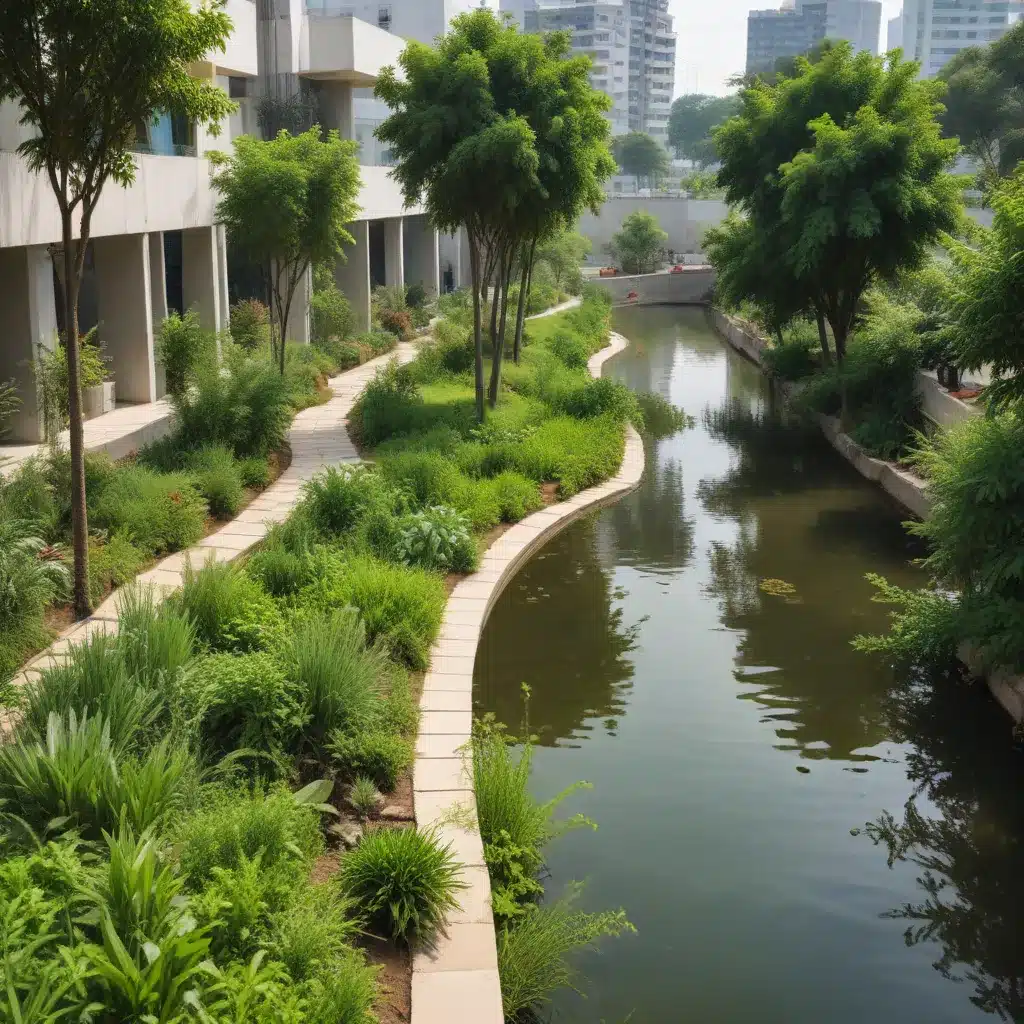
Embracing the Systemic Nature of Urban Systems
As cities worldwide face escalating environmental challenges, the integration of nature-based solutions (NBS) into urban landscape design and planning has emerged as a critical strategy for enhancing climate resilience and sustainability. Hyderabad, a rapidly growing metropolitan area in India, exemplifies the immense potential of this approach. By understanding the inherently complex, interconnected nature of urban systems, Hyderabad is pioneering the implementation of multifunctional, nature-centric interventions that address pressing water-related issues while delivering a multitude of co-benefits.
At the core of Hyderabad’s water-sensitive urban design lies the recognition that cities are not merely built infrastructures, but intricate socio-ecological-technical systems. The density of buildings, transportation networks, and human activities interacts dynamically with the city’s biophysical elements, creating a intricate web of interdependencies. This systems perspective is crucial for identifying strategic leverage points and designing interventions that can have far-reaching, positive impacts.
“Hyderabad is taking a systemic approach to harness the power of nature in addressing its water challenges. By viewing the city as a complex, interconnected system, we are able to plan and implement nature-based solutions that deliver cascading benefits across social, ecological, and technical domains,” explains Dr. Anjali Mahendra, an urban sustainability expert working closely with the city.
Balancing Human and Biodiversity Needs
Hyderabad’s water-sensitive urban design places equal emphasis on addressing human needs and enhancing urban biodiversity. The city’s planners understand that successful NBS must go beyond mere aesthetic appeal or single-purpose functionality. Rather, these nature-centric interventions must be designed to simultaneously provide ecosystem services that improve human well-being, while also creating thriving habitats and connectivity for a diversity of flora and fauna.
One exemplary project is the revitalization of the Musi River corridor, which had previously been degraded by encroachment and pollution. The river restoration effort involved the strategic placement of constructed wetlands, bioswales, and riparian buffers – not only to mitigate flood risks and improve water quality, but also to reestablish vital ecological linkages and provide new recreational spaces for the city’s residents. “By integrating ecological principles into the river’s redesign, we’ve been able to create a vibrant, multifunctional green-blue infrastructure that benefits both people and biodiversity,” says Gautam Banerjee, Hyderabad’s Chief Resilience Officer.
Ensuring Inclusive, Long-Term Solutions
Hyderabad recognizes that the implementation of NBS must be underpinned by inclusive, community-driven processes to ensure long-term sustainability and equitable outcomes. The city has pioneered innovative approaches to stakeholder engagement, drawing on the diverse knowledge, needs, and perspectives of residents, civil society organizations, and technical experts.
For instance, the design of neighborhood-scale stormwater management systems has involved extensive co-creation workshops, where community members collaborate with planners to identify optimal locations, choose appropriate plant species, and determine maintenance responsibilities. This inclusive approach not only fosters a sense of ownership, but also helps to address potential trade-offs and unintended consequences, such as the risk of property value increases and potential displacement of vulnerable groups.
“Engaging the community throughout the planning and implementation process has been crucial. It ensures that the nature-based solutions we develop are truly responsive to local needs and can be sustained over the long term,” emphasizes Sanjana Chowdhary, Hyderabad’s Director of Urban Planning.
Adapting to Local Contexts
Hyderabad’s water-sensitive urban design recognizes that successful NBS cannot be simply imported or replicated from other cities. Each urban landscape has its own unique cultural, ecological, and socio-economic context that must be carefully considered. The city’s planners have adopted a place-based approach, drawing on interdisciplinary knowledge to understand and respond to the specific challenges and opportunities of the local environment.
For example, in water-scarce areas of the city, the integration of xeriscape gardens, rainwater harvesting systems, and drought-tolerant vegetation has been a priority. These context-specific NBS not only conserve precious water resources, but also create aesthetically pleasing green spaces that celebrate the region’s natural flora. Simultaneously, in flood-prone neighborhoods, the focus has shifted to enhancing permeable surfaces, restoring urban wetlands, and developing multi-purpose detention basins that can double as community parks during dry periods.
“There is no one-size-fits-all solution when it comes to nature-based solutions. We must deeply understand the local context and work closely with diverse stakeholders to design interventions that are tailored to the unique needs and characteristics of each community,” explains Aisha Khan, Hyderabad’s Sustainable Development Coordinator.
Fostering Communication and Learning
Hyderabad’s water-sensitive urban design approach recognizes that the successful mainstreaming of NBS requires sustained communication, education, and learning opportunities for both decision-makers and the general public. The city has implemented a multi-pronged strategy to raise awareness, build capacity, and cultivate a shared understanding of the value of nature-based solutions.
Regular training workshops, site visits, and knowledge-sharing platforms bring together urban planners, landscape architects, ecologists, and community members to exchange best practices and lessons learned. At the same time, public awareness campaigns and educational programs have helped to foster a deeper appreciation for the role of nature in addressing urban challenges and enhancing livability.
“We’ve found that creating spaces for continuous learning and dialogue is essential. It allows us to collectively refine our approaches, address emerging issues, and ensure that nature-based solutions remain at the forefront of Hyderabad’s sustainable development agenda,” says Ravi Kiran, Hyderabad’s Environmental Education Coordinator.
Nurturing a Nature-Centric Future for Hyderabad
Hyderabad’s water-sensitive urban design, rooted in the integration of nature-based solutions, represents a transformative approach to addressing the complex, interconnected challenges facing cities in the 21st century. By embracing a systems perspective, balancing human and biodiversity needs, ensuring inclusive long-term solutions, adapting to local contexts, and fostering continuous communication and learning, the city is pioneering a model of sustainable, resilient urban development that can inspire and inform similar efforts worldwide.
As Hyderabad continues to evolve, its commitment to nature-based solutions will be a crucial factor in shaping a more livable, equitable, and ecologically vibrant future for its growing population. Through this holistic, nature-centric approach, the city is poised to become a global leader in urban sustainability, offering valuable insights and practical guidance for cities seeking to harness the power of nature to create thriving, resilient communities.

